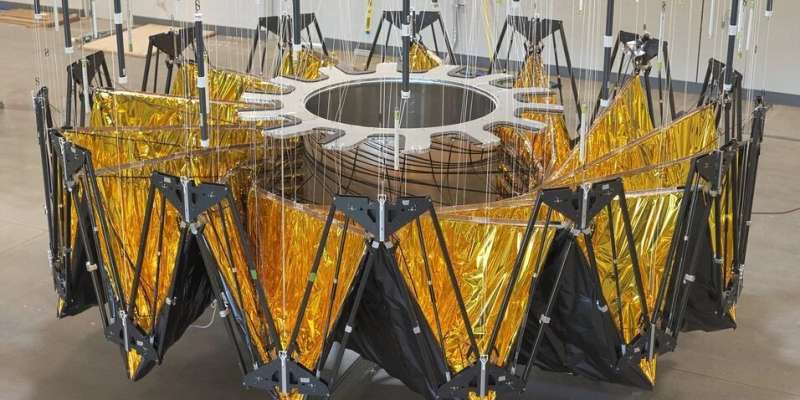Figuring out the answer to this question is central to enabling future space missions that will one day search for Earth-like exoplanets and spacecraft that will better measure the Earth system using radar remote-sensing. And at the forefront of using the principles of origami to discover potential solutions for this problem is aerospace engineer Manan Arya.
"When we talk about large sheet-like structures, things like solar arrays or antenna reflectors for spacecraft, they look like large, thin sheets of material," says Arya, who leads the Stanford Morphing Space Structures Lab. "So it's kind of natural to think, 'oh, we put creases, we put folds everywhere.'"
Mathematicians and physicists have become increasingly intrigued by origami over the past 30 years, says Arya, especially understanding the mechanics of folding thin, sheet-like materials. Origami, explains Arya, raises many questions and problems about geometry, fold patterns, and the mechanics of folding and crumpling sheet-like materials like paper. "A number of these problems have been addressed by mathematicians and physicists, and a number of these alluring problems are unsolved."
They aren't the only ones who have experienced the allure of origami. "In the last 20 years or so," he says, "there have been more and more engineers who've been taking all these kinds of mathematical, physical ideas, and adapting them for use in making products."
Arya started in this field as an undergraduate at the University of Toronto while he was doing work with solar sails, which are very thin sails that use the sun's radiation to propel small spacecraft, freeing them of the need to carry heavy propellant. To capture as much radiation as possible, these solar sails are massive, up to 20-by-20 meters, while the spacecraft itself is the size of a loaf of bread. "Very quickly, I veered into the problem of how do you package these sails into the spacecraft?" says Arya. "It ended up being quite an interesting problem in terms of how do we package that, how do we fold that, and that's how I got into origami."
Arya graduated from the University of Toronto in 2011 and received his Ph.D. in 2016 from Caltech. Before arriving at Stanford earlier this year, he brought his interest in origami to Caltech's Jet Propulsion Laboratory. While there, he designed and tested origami-inspired folding schemes to help solve a significant challenge in aerospace engineering: searching for Earth-like exoplanets.
The search for such exoplanets is a critical area of exploration within NASA, but trying to find these planets, Arya says, is "like trying to take a picture of a firefly that's hovering next to a searchlight." The stars around which these exoplanets orbit are 1–10 billion times brighter than the planet itself, so even the most powerful telescopes struggle to pick up their relative faint glow. (According to Arya, if you do the math, taking a picture of the firefly is about a thousand times easier.)
One possible solution to this challenge is creating a device called a starshade, which is essentially a large disk that creates a kind of artificial eclipse that can suppress starlight by a factor of 10 billion, allowing scientists to finally see the exoplanets they're searching for. Arya's model for a starshade is bright gold and reflective, with a spiral unfolding like a blooming flower. When fully unfolded, Arya's starshade is 26 meters in diameter, about the length of a basketball court, and has been designed to fit into a cylinder that's about 2 meters tall and 2.5 meters in diameter.
But as elegant and visually striking as it is, he says it's not quite ready to be deployed. "Starshade is not going to fly in its current version. We're still very much in technology development," says Arya. This is because, he explains, NASA desires new technologies to be at a certain Technology Readiness Level, or TRL, before they get incorporated into space missions. Starshade is between TRL4 and TRL5, meaning it needs some more testing and analysis before it reaches TRL6, which is when NASA starts preparing for a space mission.
More recently, Arya has become interested in origami that doesn't start with what's essentially a simple flat sheet of paper—but rather something more akin to folding an enormous piece of kale. "It's frilly, it's got all this corrugation to it; you can never flatten that piece of kale," Arya explains. The corrugations add strength and stability to spacecraft structures, which allow them to take on additional functions, such as load bearing, that are not possible with thin sheet-like materials. For Arya this presents a new set of challenges: How do you take the rules of origami, which were developed for flat sheets of paper, and apply them to things that are not flat?
Among the origami purists, this may seem like a fold too far. Traditional aficionados of the art hold an expectation that every origami pattern starts with a single sheet of paper, with no cuts, no gluing multiple sheets of paper together. But as Arya enters into the realm of packaging kale-like space structures, he knows he's going to have to break this cardinal rule. "We're engineers, right? We can make cuts. We can glue on more paper or stack multiple sheets of paper together. And that gives rise to interesting behaviors, interesting mechanics that are useful for engineers."
Indeed, as the rules get bent and broken, the number of solutions for morphing space structures expands. "The design space," says Arya, "is unlimited."
Explore further



